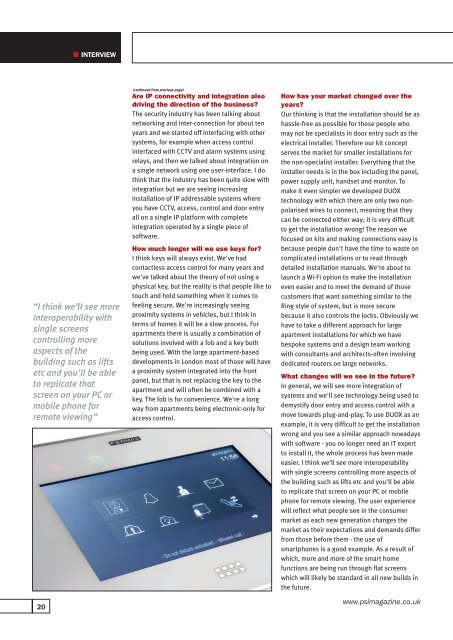PSIJuly2018
Create successful ePaper yourself
Turn your PDF publications into a flip-book with our unique Google optimized e-Paper software.
INTERVIEW<br />
“I think we’ll see more<br />
interoperability with<br />
single screens<br />
controlling more<br />
aspects of the<br />
building such as lifts<br />
etc and you'll be able<br />
to replicate that<br />
screen on your PC or<br />
mobile phone for<br />
remote viewing”<br />
20<br />
(continued from previous page)<br />
Are IP connectivity and integration also<br />
driving the direction of the business?<br />
The security industry has been talking about<br />
networking and inter-connection for about ten<br />
years and we started off interfacing with other<br />
systems, for example when access control<br />
interfaced with CCTV and alarm systems using<br />
relays, and then we talked about integration on<br />
a single network using one user-interface. I do<br />
think that the industry has been quite slow with<br />
integration but we are seeing increasing<br />
installation of IP addressable systems where<br />
you have CCTV, access, control and door entry<br />
all on a single IP platform with complete<br />
integration operated by a single piece of<br />
software.<br />
How much longer will we use keys for?<br />
I think keys will always exist. We've had<br />
contactless access control for many years and<br />
we've talked about the theory of not using a<br />
physical key, but the reality is that people like to<br />
touch and hold something when it comes to<br />
feeling secure. We're increasingly seeing<br />
proximity systems in vehicles, but I think in<br />
terms of homes it will be a slow process. For<br />
apartments there is usually a combination of<br />
solutions involved with a fob and a key both<br />
being used. With the large apartment-based<br />
developments in London most of those will have<br />
a proximity system integrated into the front<br />
panel, but that is not replacing the key to the<br />
apartment and will often be combined with a<br />
key. The fob is for convenience. We're a long<br />
way from apartments being electronic-only for<br />
access control.<br />
How has your market changed over the<br />
years?<br />
Our thinking is that the installation should be as<br />
hassle-free as possible for those people who<br />
may not be specialists in door entry such as the<br />
electrical installer. Therefore our kit concept<br />
serves the market for smaller installations for<br />
the non-specialist installer. Everything that the<br />
installer needs is in the box including the panel,<br />
power supply unit, handset and monitor. To<br />
make it even simpler we developed DUOX<br />
technology with which there are only two nonpolarised<br />
wires to connect, meaning that they<br />
can be connected either way; it is very difficult<br />
to get the installation wrong! The reason we<br />
focused on kits and making connections easy is<br />
because people don't have the time to waste on<br />
complicated installations or to read through<br />
detailed installation manuals. We're about to<br />
launch a Wi-Fi option to make the installation<br />
even easier and to meet the demand of those<br />
customers that want something similar to the<br />
Ring style of system, but is more secure<br />
because it also controls the locks. Obviously we<br />
have to take a different approach for large<br />
apartment installations for which we have<br />
bespoke systems and a design team working<br />
with consultants and architects-often involving<br />
dedicated routers on large networks.<br />
What changes will we see in the future?<br />
In general, we will see more integration of<br />
systems and we'll see technology being used to<br />
demystify door entry and access control with a<br />
move towards plug-and-play. To use DUOX as an<br />
example, it is very difficult to get the installation<br />
wrong and you see a similar approach nowadays<br />
with software - you no longer need an IT expert<br />
to install it, the whole process has been made<br />
easier. I think we’ll see more interoperability<br />
with single screens controlling more aspects of<br />
the building such as lifts etc and you'll be able<br />
to replicate that screen on your PC or mobile<br />
phone for remote viewing. The user experience<br />
will reflect what people see in the consumer<br />
market as each new generation changes the<br />
market as their expectations and demands differ<br />
from those before them - the use of<br />
smartphones is a good example. As a result of<br />
which, more and more of the smart home<br />
functions are being run through flat screens<br />
which will likely be standard in all new builds in<br />
the future.<br />
www.psimagazine.co.uk

















